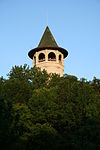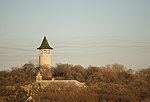Franklin Avenue Bridge

The Franklin Avenue Bridge, officially the F.W. Cappelen Memorial Bridge, carries Franklin Avenue over the Mississippi River in Minneapolis, Minnesota. It was designed by Frederick William Cappelen, assisted by Kristoffer Olsen Oustad, both of whom were among four important Norwegian-American engineers working in the region at the time. The reinforced-concrete open-spandrel arched structure was completed in 1923. The bridge's overall length is 1054.7 feet (321.47 m), with a central span of 400 feet (122 m). It was added to the National Register of Historic Places in 1978 along with several other area bridges as part of a multiple-property submission. At the time of its completion, the bridge's central span was the longest concrete arch in the world. The bridge originally carried streetcars, which were removed in the 1940s. A major renovation in the early 1970s changed many of the ornamental details and widened a completely replaced deck. A bike lane was added in 2005. The bridge was extensively rehabilitated between 2015 and 2017, including restoring some of the details lost in the 1970s reconstruction
Excerpt from the Wikipedia article Franklin Avenue Bridge (License: CC BY-SA 3.0, Authors, Images).Franklin Avenue Bridge
West River Parkway Trail, Minneapolis Seward
Geographical coordinates (GPS) Address External links Nearby Places Show on map
Geographical coordinates (GPS)
| Latitude | Longitude |
|---|---|
| N 44.963888888889 ° | E -93.222777777778 ° |
Address
Franklin Avenue Bridge
West River Parkway Trail
55455 Minneapolis, Seward
Minnesota, United States
Open on Google Maps









